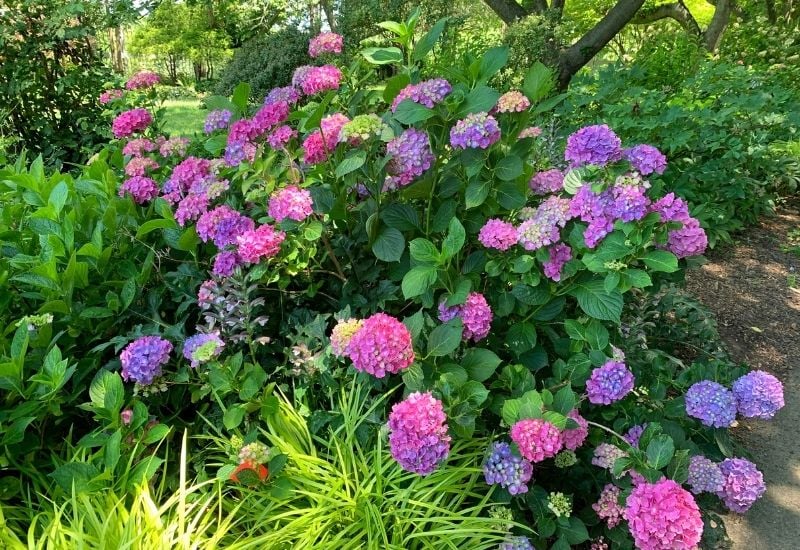
If you think that shade and flowers don’t go well together, think again. Many plants, and especially shade-tolerant flowering shrubs, like to open their buds in gardens where light is low, where they can add colors and fragrance to your fresh green haven.
And this is on top of giving you structure, foliage, and even bright berries in some cases! In fact, a few bushes planted under trees, trellises or near walls will turn “darkness” into light, life and – well, a real garden!
Many blooming bushes are particularly suited for partial shade, dappled shade, light shade and some even to full shade. You can use them for borders, hedges, flower beds, containers and even as underbrush some times where the Sun don’t shine.
Which flowering shrubs grow well in shade? For colder or warmer climates, big or small, we have found out the ultimate selection of flowering shrubs for shade to bring an instant burst of color to your sun-deprived garden from early spring to frost!
But how could we find so many beauties that grow where light is scarce? I’ll tell you how…
Shrubs, Shade and Flowers
Why do shrubs bloom in shady places more than other plants? Simple, many are used to growing in poorly lit areas in their natural environment.
Trees reach up to the sky, small flowers, and especially annuals often like a sunny spot. But if you look under the canopy of trees in forests, what will you find? Bushes and vines galore!
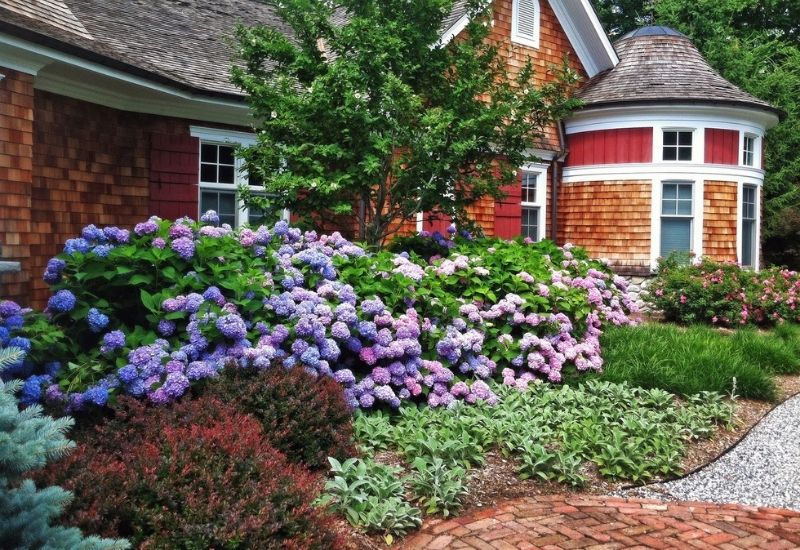
How to Use Flowering Shrubs in Shady Gardens
Shrubs are ideal to fill in gaps and give structure to borders and gardens in general. Even better if they bloom. What is more, shrubs can block views from outside or hide unpleasant structures, like walls and sheds.
But they also have a very special design function. A tall tree next to small flowers looks beautiful, but not natural and in many cases, not even harmonic. Why? It lacks a level, a dimension. Shrubs bring all the elements of a garden or terrace together.
And finally, you need to look up to see the blooms of trees, and down to admire low growing flowers, but you have shrubs straight in front of your nose, at eye level!
Fancy choosing one from our list? We have picked some of the most beautiful for you!
14 Most Beautiful Flowering Shrubs for Shade
A wide range of flowering shrubs appreciate being protected from the blazing rays of the sun, especially in the middle of summer. However, even these shadow artists reach their limits under pitch-dark, deep-reaching treetops.
Even very shade-tolerant shrubs need a few “light” moments in their shadowy existence if they are to be able to cope with the lack of light in the long term.
These shade-loving flowering shrubs will fill shaded green space in your garden and yard with plenty of color from spring till early fall.
1. Winter Daphne (Daphne odorosa ‘Aureomarginata’)
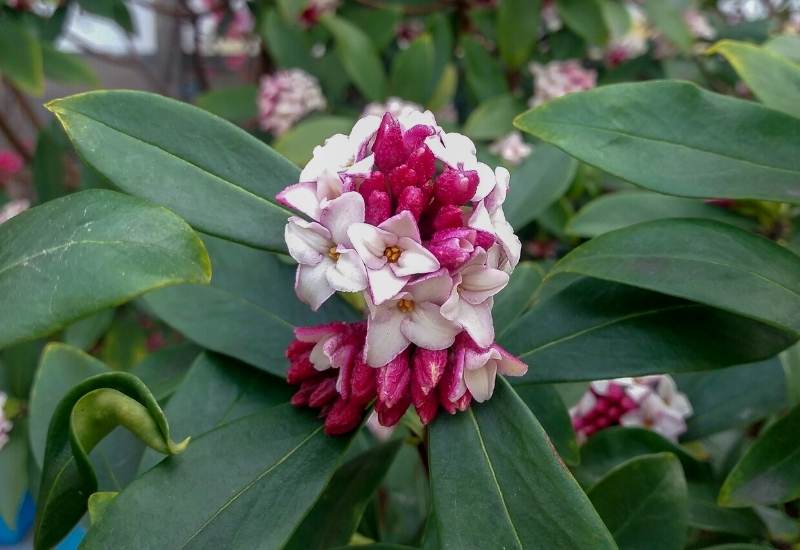
Winter daphne is a spectacle of flowers, foliage and berries all year round, perfect for shady spots in need of life… The lilac blooms come in clusters every spring at the tips of branches, with their star shaped beauty and sweet fragrance.
They will turn into purple fruits by late summer, to the delight of birds. And the leathery, cream and green foliage will be with you all year round, as this shrub is evergreen.
Winter daphne is a hardier variety than other members of its species and small enough to fit into a medium sized containers, so you can enjoy it even in colder climates and small spaces, in informal borders, beds, wind screens and hedges.
2. ‘Cornelia’ Hybrid Musk Rose (Rosa ‘Cornelia’)
Surprised to find a rose among shade loving flowering shrubs? ‘Cornelia’ is a hybrid musk variety with fully double flowers in rosette shape with 55 petals each. They reach 3 inches across (7.5 cm) and they have a very strong fragrance.
They will start off as apricot pink and turn copper pink later in their bloom. And this is all set against the glossy dark bronze foliage if this beautiful shrub. This rise has won the Award of Garden Merit by the Royal Horticultural Society.
‘Cornelia’ is ideal for beds and borders, and it is a late bloomer, so it can give you brightness in shady corners even in fall, and it really looks lovely in traditional gardens and terraces, countryside inspired settings and most informal gardens.
3. Japanese Anise (Illicium anisatum)
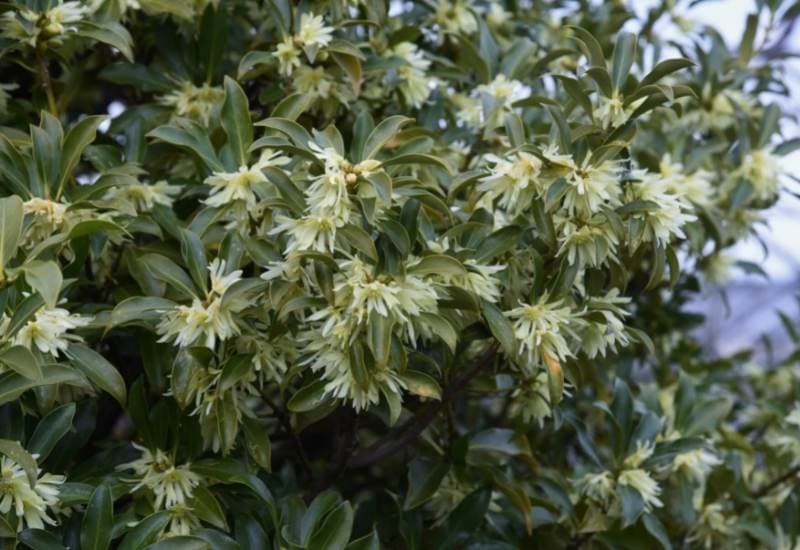
Japanese anise is the ideal flowering shrub for shady and wet areas. It has cream white flowers with many petals, not showy individually, but they look lovely when they bloom together because the foliage sets them off perfectly well.
In fact the leaves are dark emerald, glossy and oval, quite large and lush, up to 4 inches long (10 cm).
They are aromatic too, and in fact this plant is used to make incense. The contrast between dark and light hues gives you an elegant and slightly exotic bush with a fresh appearance. The conical shape of the bush and can give your garden structure as well.
Grow Japanese anise against walls, in screens or borders, make the best of it thick a and dark foliage to achieve that “sheltered and place” look we all love in private parts of our gardens, where you can sip on a refreshing drink without prying eyes looking in…
4. Redvein Enkianthus (Enkianthus campanulatus)
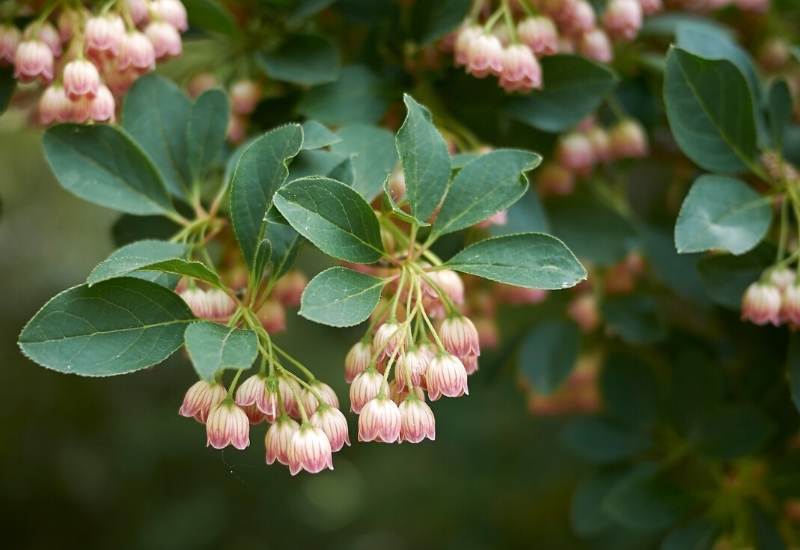
Redvein is a colorful shrub that grows well and blossoms profusely in partial shade and in colder climates, like New England, Maine, etc.
The flowers are bell shaped and nodding, cream with red edges, and they come in lovely clusters on the tips of the branches.
The foliage is beautifully textured with light green leaves till fall, when they turn into an explosion of fiery red, and the thick branches supports this spectacle perfectly well, giving you a compact and dense effect.
No surprise that it has won the Award of Garden Merit by the Royal Horticultural Society.
Redvein enkianthus is also disease free, which makes for loa maintenance in traditional looking, informal and cottage gardens, but as it can be pruned into geometrical shapes, and you can even train it into a small tree, it will suit also more formal settings, like urban and courtyard gardens and terraces.
5. Japanese Andromeda (Pieris ‘Brouwer’s Beauty’)
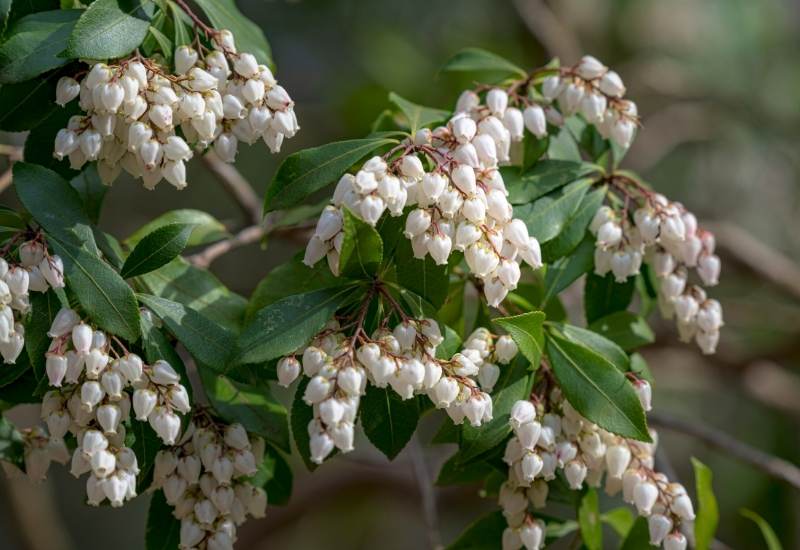
Grow Japanese Andromeda for landscaping in shady gardens, and it will solve many problems. It has massive blooms of urn shaped pendulous flowers, which come on straight trusses at the end of branches.
And this will start happening in winter! The foliage frames them well, with its long mid green and glossy oval leaves; these will stay on all year, including winter.
And the compact habit of this shrub is perfect to close off views and fill in even fairly large gaps in gardens.
It is a hybrid from a North American and a Japanese species, so, a meeting of East and West, and a winner of the Cary Award.
Japanese Andromeda is fairly cold hardy and very sturdy; you can grow it for foundation planting, hedges, and it is perfect for banks and slopes as well.
6. ‘Desire’ Camellia (Camellia japonica ‘Desire’)
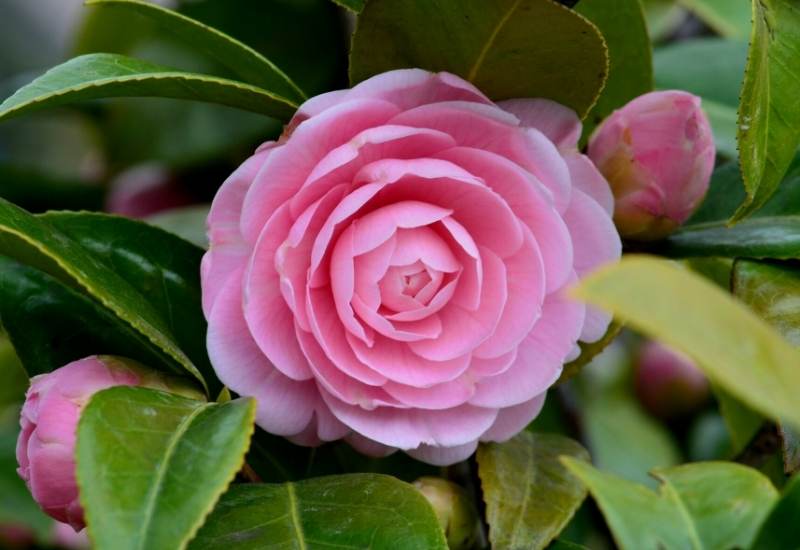
Camellias are shrubs that love shade, but we have chosen a spectacular variety for you: ‘Desire’. The blooms are large, about 4 inches across (10 cm), fully double and the 60 petals (!!!) are arranged very regularly, giving you a perfect rosette, and…
The flowers are white in the center but they fade into pink with hints of magenta at the margins!
And it’s a repeat bloomer as well! All this is set against the iconic dark green and glossy evergreen foliage of this famous shrub. Guess what? It has won the Award of Garden Merit by the Royal Horticultural Society.
‘Desire’ camellia is perfect for all informal settings and ideal for containers and terraces in the shade, where you can control the soil’s acidity and find this shrub a shelter if you live in colder climates.
7. ‘Zorro’ Hydrangea (Hydrangea macrophylla ‘Zorro’)
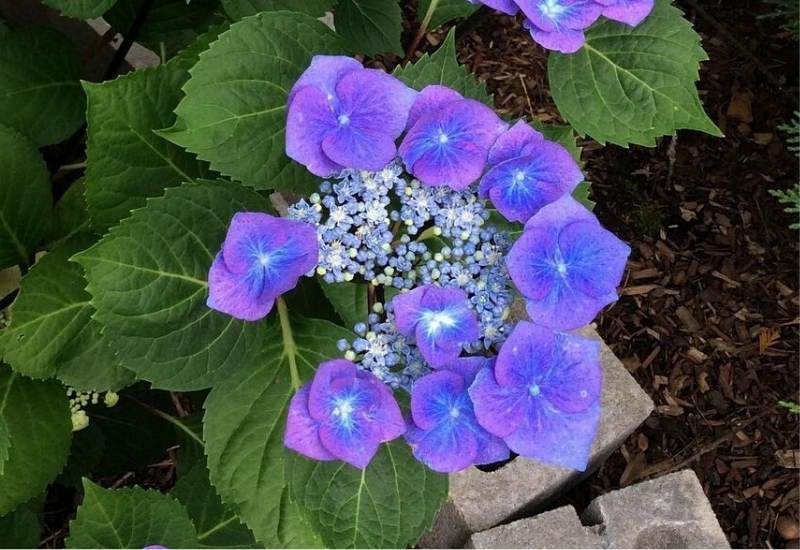
Hydrangeas are popular blooming shrubs for shade, but we chose one cultivar for you, ‘Zorro’, for a reason…
Experts regard it as the lacecap variety with by far the best blue shade. But this is not the only color the large and generous inflorescences have…
Late in the season, what used to be deep blue flowers turn rich pink! And you also get purple stems and lush green foliage.
Winner of the Award of Garden Merit by the Royal Horticultural Society, it os only one of the many varieties you can choose from if you want colors where light is scarce.
‘Zorro’ is also a very small hydrangea, so it is perfect for modest spaces in gardens or terraces; yes, because you can even grow it in containers, a rare quality in this species of blooming shrubs!
8. Mountain Laurel (kalmia latifolia)
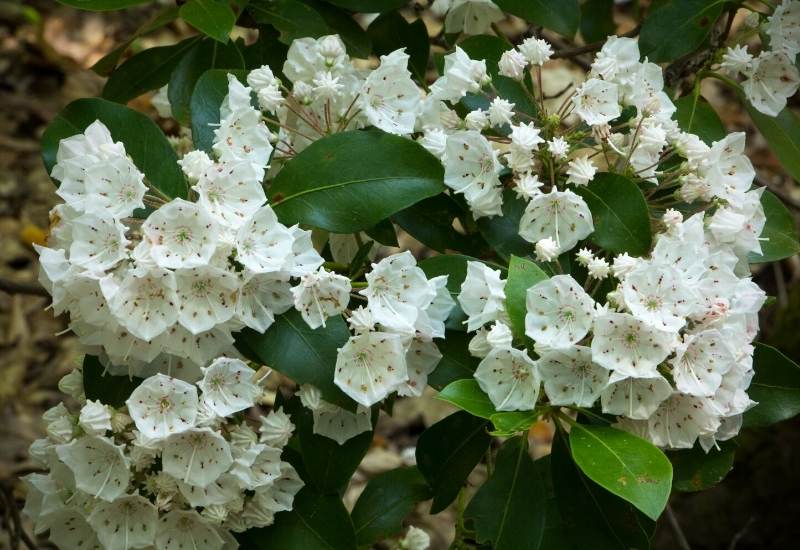
Mountain laurel is a perfect flowering shrub for shady temperate gardens. The blooms have an original bowl shape, which opens to a pentagon at the mouth, revealing the bright magenta dots in the pale pink petals. They come in bog clusters and will last for weeks.
The leaves are bright green, oval and long, and they darken as the season progresses, just as the fruits mature to brown and stay on, with the foliage, in winter. This native US plant has won the Cary Award.
Mountain laurel is small enough to fit into most gardens, cold hardy and low maintenance, and as long as the design is informal, traditional and not exotic, it will be a great asset to your green haven.
9. ‘Lemon and Lime’ Japanese Quince (Chaenomeles x superba ‘Lemon and Lime’)
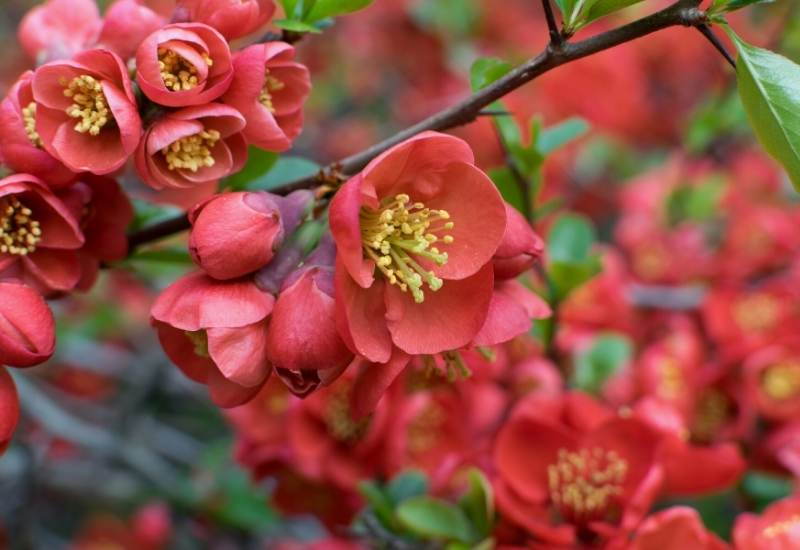
We could have picked any Japanese quince for your shady garden but we chose ‘Lemon and Lime’ for its bright and fresh looking look.
The name describes the delicate lime to lemon yellow shade of the flowers, which are soft looking, round and 1.5 inches across (4.0 cm).
They are excellent to bring light and an effervescent freshness to sheltered places, with the bright emerald foliage as perfect backdrop.
It will also give you yellow fruits in summer, which you can pick and eat, but they are bitter, so use them for jellies and jams. And if you prefer different colors, these plants come in all the warm and white range.
‘Lemon and Lime’ is a small to medium sized shrub that softens any hedge, border or screen; it will cover walls with colors and beauty with its informal and natural presence.
10. ‘Purple Diamond’ Chinese Fringe Flower (Loropetalum chinense ‘Purple Diamond’)
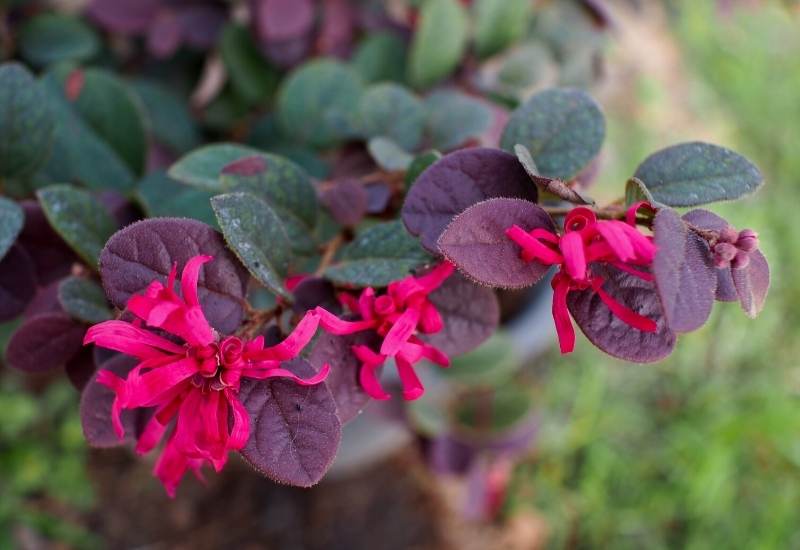
‘Purple Diamond’ is a cultivar of Chinese fringe flower that brings depth of color to shady gardens and terraces. The blooms look like deep magenta purple feathers at the end of branches, delicate and bright.
But the name also refers to the oval, glossy and dense oval foliage of this compact shrub too. In fact, the leaves are of a very rich, dark purple, though some start off as dark green.
‘Purple Diamond’ is perfect to vary the color of foliage in dappled and partial shade, with a round habit and flowers that look great in containers against walls, in hedges and borders.
11. ‘Ginny Gee’ Evergreen Rhododendron (Rhododendron ‘Gimmy Gee’)
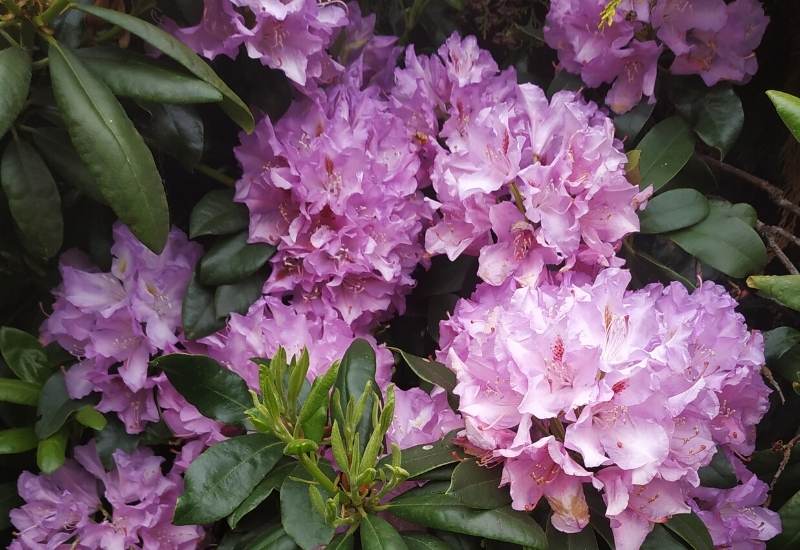
‘Gimmy Gee’ is a showy shrub of the shade loving rhododendron genus with amazing gardening potential. The blooms are packed in thick clusters and very abundant, and each flower is a beauty to behold.
Bright snow white in the center, with pink to magenta along the edges, they are a spectacular bicolor variety! They will totally cover the bush for a few weeks, and then you will be left with the deep green, dense and refreshing foliage all year round. This prized cultivar has won the Award of Garden Merit by the Royal Horticultural Society.
What is more, ‘Gimmy Gee’ is a dwarf variety of rhododendron, perfect for tiny spaces including terraces. But if you want bigger and other colors, rhododendrons offer an impressive range for your shady spot.
12. Dog Hobble (Leucothoe fontanesiana)
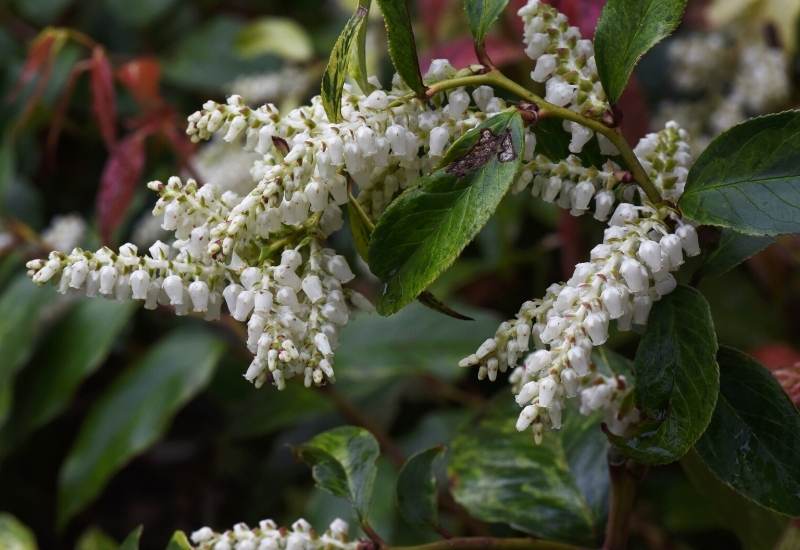
Dog hobble looks perfect in shaded gardens with a temperate and traditional, “woody” look. The blooms are like soft dropping clusters of cream colored and urn shaped flowers – and loads of them! They will hang beneath the foliage, weighing down the branches and making them arch gracefully.
The evergreen leaves are oval, pointed, deep green and glossy. It is a magnet for pollinators and butterflies, and it has a very decided underbrush look.
Dog hobble is a good shrub for ground cover in shady places, as long as you trim it low, where it will form a carpet that recalls the low levels of temperate forests, but even in borders, on slopes and on the banks of rivers and ponds it does look great!
13. Tree Peony (Paeonia suffruticosa)
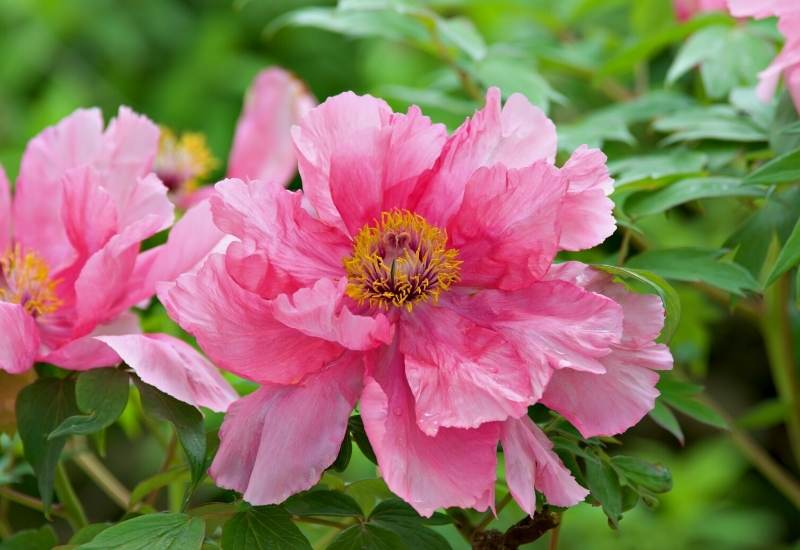
Tree peony is a small shrub with semi double round and cupped blooms, perfect for shady gardens as they have a range of colors to brighten them up: white, pink, red or purple – you choose! The softly nodding flowers will hang over the round shaped bush, with amazingly decorative rich green foliage.
The leaves, in fact, are finely divided and vey dense, excellent for texture. It is a lesser known early flowering variety of peony, nevertheless, one that can become a real asset for gardens and terraces alike.
Grow tree peony for both blooms and foliage in sheltered places, under trees or even in borders and beds, and the traditional garden look is yours! And if yours is a terrace, grow it in a container instead.
14. Chinese Sweetshrub (Calycanthus chinensis)
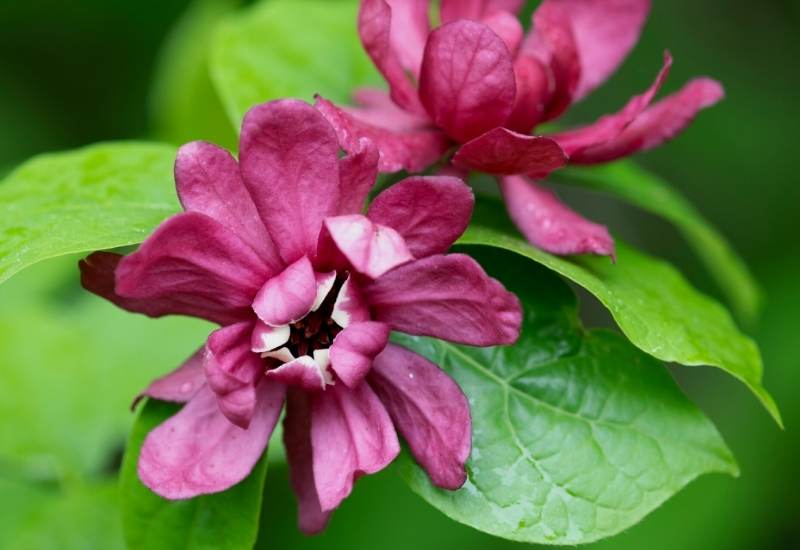
Chinese sweetshrub is a shade loving shrub that mixes the exotic with the temperate look. The flowers are large, 3 inches across, round, and showy. They are white with blushes of lavender pink at the margins of the broad and softly veined petals (tepals).
Then, on the inside, you will see a crown of smaller and upright yellow tepals that crown the pistils and stamen. All this framed by broad, elliptical, bright green leaves that reach 6 inches in length (15 cm). These will turn yellow in fall, giving your shady spot a final burst of light!
Chinese sweetshrub is shrub that brings light into dark corners; it is perfect in borders, as a wall side shrub or in containers, as long as you have enough space for this medium sized bush.
Bring Light and Life to Your Green Space in the Shade
Amazing, isn’t it, how many different varieties of flowering shrubs you can grow in the shade in gardens and terraces. Some are big, some so small that they can fit in a small pot, but you will agree with me, it’s really hard to pick one…

Written By
Amber Noyes
Amber Noyes was born and raised in a suburban California town, San Mateo. She holds a master’s degree in horticulture from the University of California as well as a BS in Biology from the University of San Francisco. With experience working on an organic farm, water conservation research, farmers’ markets, and plant nursery, she understands what makes plants thrive and how we can better understand the connection between microclimate and plant health. When she’s not on the land, Amber loves informing people of new ideas/things related to gardening, especially organic gardening, houseplants, and growing plants in a small space.

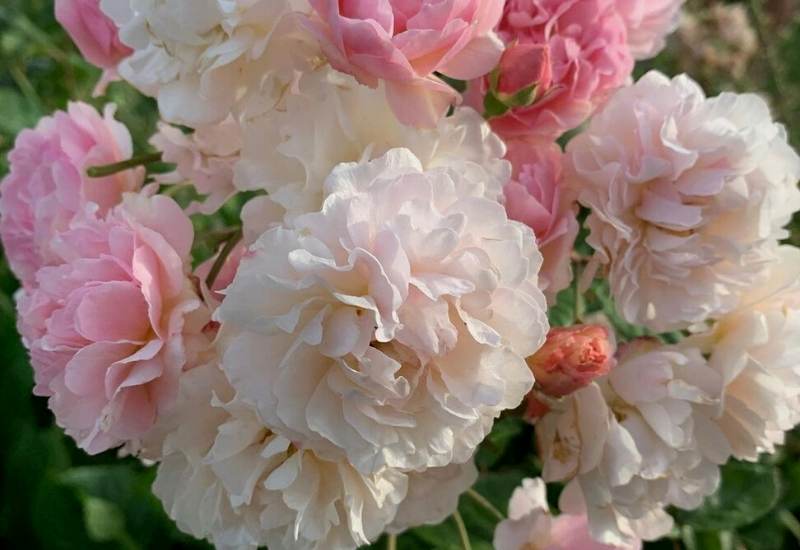
Wonderful information in your articles! Thanks